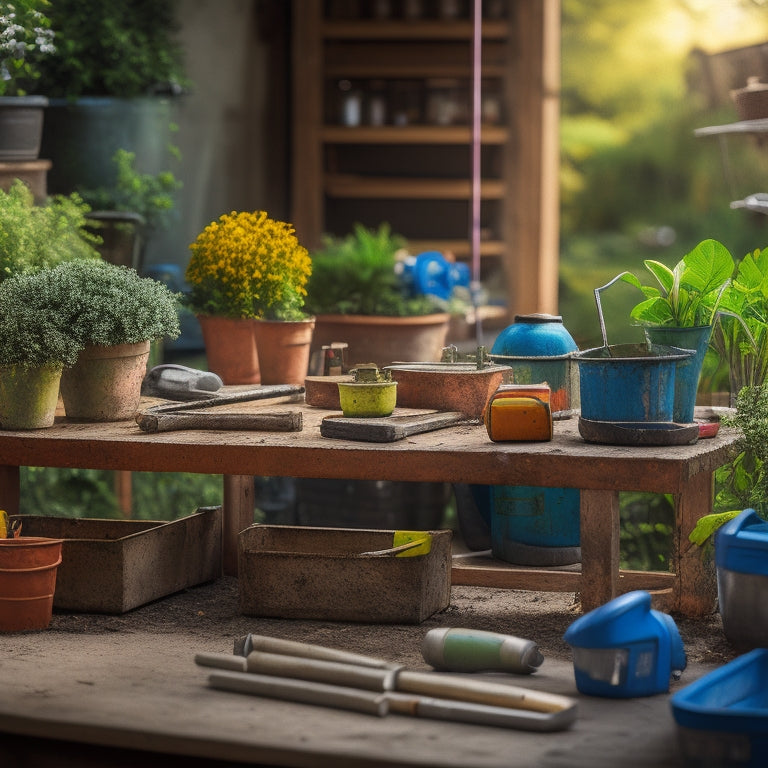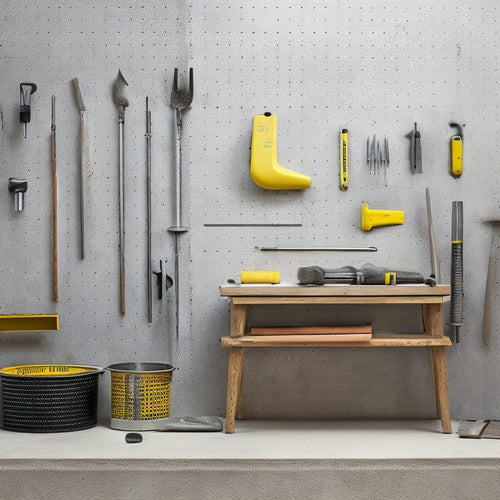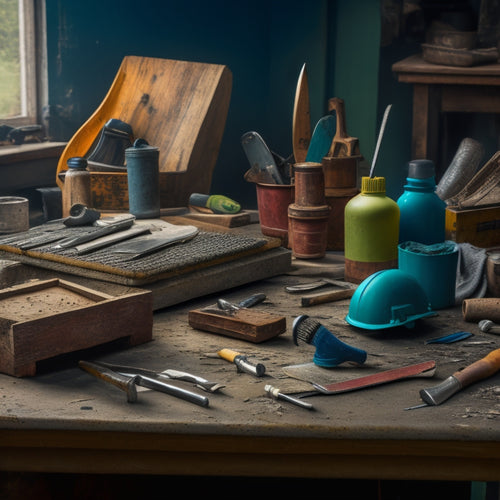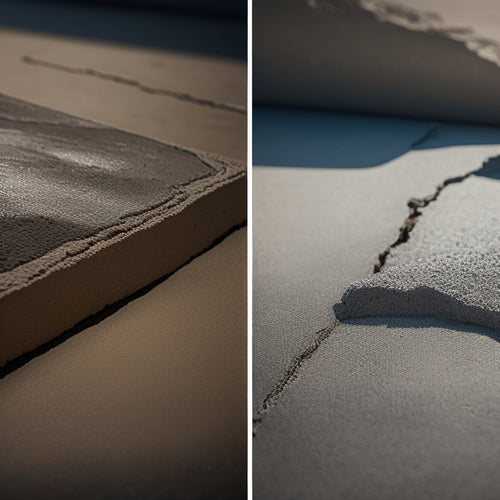
Must-Have Tools for Concrete Planter Projects
Share
As you commence your concrete planter project, you'll need a range of specialized tools to achieve professional-grade results. Start with essential safety gear, including gloves, goggles, and a face mask, to protect yourself from abrasions and harmful particles. Next, gather measuring and marking tools, like a reliable tape measure and high-contrast markers, to guarantee accurate dimensions and precise lines. From there, you'll need mixing equipment, pouring tools, and cutting tools, such as a sturdy mixing bucket, a curved pouring lip, and a masonry saw, to shape and size your concrete. With these must-haves in hand, you'll be ready to craft stunning, durable planters that showcase your creativity – and with a little more exploration, you'll reveal the secrets to bringing your vision to life.
Key Takeaways
- Safety gear, including gloves and protective eyewear, is essential for protecting yourself from abrasions and harmful particles during concrete planter projects.
- Measuring and marking tools, such as tape measures and marking gauges, ensure accurate dimensions and precise lines in your concrete planters.
- Mixing equipment, including sturdy buckets and mixing sticks, helps you achieve the right consistency and ratio of cement, sand, and water for your concrete mixture.
- Pouring tools, like pouring buckets and vibrating tables, facilitate smooth and even pours, and help remove air pockets for a strong and durable planter.
- Cutting tools, including masonry saws and concrete nippers, enable precise sizing and shaping of cinder blocks for a professional-looking finish.
Safety Essentials for Protection
As you commence your concrete planter project, caution becomes your closest ally, shielding you from the harsh realities of working with unforgiving materials. Concrete can be brutal, so it's vital to prioritize your safety above all else.
Start by investing in essential safety gear, such as durable gloves, a long-sleeved shirt, and pants to protect your skin from abrasions and scratches. Don't forget to wear closed-toe shoes with good traction to prevent slips and falls.
Protective eyewear is also a must-have. Concrete dust and debris can be hazardous to your eyes, so make sure to wear goggles or safety glasses that provide maximum protection. A face mask or respirator can also help prevent inhalation of harmful particles.
By taking these precautions, you'll be able to focus on bringing your creative vision to life without worrying about your well-being. Remember, safety isn't an afterthought – it's an integral part of the concrete planter project process.
With the right safety essentials, you'll be able to work confidently and efficiently, ensuring a successful outcome.
Measuring and Marking Tools
As you begin your concrete planter project, you'll need to measure and mark your materials with precision. A reliable tape measure is essential for taking accurate readings, and you'll want to choose one that's sturdy, easy to read, and has a long enough blade to span your project's dimensions.
When it comes to marking, you'll need a set of high-contrast markers or a marking gauge to create clear, precise lines that guide your cuts and pours.
Tape Measures Matter
Your concrete planter project's success hinges on accurate measurements, and that's where your trusty tape measure comes in. You'll be using it to measure everything from the size of your planter box to the diameter of the drainage holes.
With so much riding on precise measurements, it's crucial to choose the right tape measure for the job.
There are several types of tape measures to evaluate, each with its own strengths and weaknesses. Here are three key factors to keep in mind:
-
Tape types: Fiberglass tapes are great for outdoor use, while steel tapes are better suited for indoor projects. Nylon-coated tapes offer a durable, water-resistant option.
-
Measuring techniques: Learn to use the "hook and hold" method for accurate readings, and don't be afraid to use a ladder or step stool to get those hard-to-reach measurements.
-
Tape length and width: Choose a tape measure with a sufficient length to reach across your planter box, and evaluate a wider tape for easier readings.
Accurate Marking Essentials
A precise mark can make all the difference in your concrete planter project, turning a rough estimate into a refined reality. To achieve this, you'll need a set of accurate marking essentials that guarantee your layout strategies are on point.
Invest in a high-quality pencil, like a carpenter's pencil or a graphite pencil, which will leave a clear, dark mark on your concrete. For more intricate marking techniques, consider a fine-tip marker or a felt-tip pen. These tools will allow you to create precise lines and shapes, giving your planter a professional finish.
A marking gauge will also come in handy, helping you create consistent spacing and alignment. Don't forget a scraper or a marker remover to correct any mistakes or remove old marks.
Mixing and Pouring Equipment
As you prepare to mix and pour concrete for your planter project, you'll need the right equipment to guarantee a successful outcome.
A sturdy mixing bucket with essential tools like a mixing stick, trowel, and gloves will help you achieve a consistent mix.
Next, you'll need concrete pouring tools, such as a pouring pot and chute, to smoothly transfer the mix into your mold, along with measuring and scooping tools to accurately portion out the right amount of concrete.
Mixing Bucket Essentials
Behind every successful concrete planter project lies a well-stocked mixing bucket, equipped with the right tools to get the job done efficiently.
As you prepare for your concrete planter project, it's vital to have a mixing bucket that's the right size for the job. You'll want to take into account the volume of concrete you need to mix and the space you have available to work.
When it comes to mixing techniques, having the right tools can make all the difference. Here are the must-haves for your mixing bucket:
-
Drill with mixing paddle: A drill with a mixing paddle attachment is a game-changer for mixing large quantities of concrete. It saves time and energy, guaranteeing a smooth, consistent mix.
-
Tamping tool: A tamping tool helps to remove air pockets and guarantees the concrete is evenly distributed in the bucket.
-
Measuring cups and spoons: Accurate measurements are vital in concrete mixing. Having measuring cups and spoons on hand guarantees you get the right ratio of cement to water.
With these essentials in your mixing bucket, you'll be well on your way to creating stunning concrete planters that will impress anyone.
Concrete Pouring Tools
Pour your mixed concrete into the mold with confidence, knowing you have the right tools for the job. A sturdy pouring bucket or scoop is essential for controlling the flow of concrete into the mold. Look for one with a curved or angled lip to facilitate smooth, even pours. A pouring spout or chute can also be attached to the bucket to reduce mess and improve accuracy.
When pouring, consider the temperature of your concrete. Ideal pouring temperatures range from 50°F to 70°F (10°C to 21°C), as this allows for proper flow and setting. Avoid pouring in direct sunlight or during extreme weather conditions, as this can affect the concrete's consistency and final appearance.
To achieve a smooth, bubble-free finish, use a vibrating table or a handheld vibrating tool to remove air pockets from the mold.
For more complex pours, consider using a concrete pump or a pressure pot to guarantee consistent flow and pressure. By mastering concrete pouring techniques and considering temperature and environmental factors, you'll be well on your way to creating stunning, professional-grade concrete planters.
Measuring and Scooping
With your concrete mixed to perfection, it's time to focus on accurately measuring and scooping the right amount into your mold. Measuring accuracy is vital to guarantee your planter turns out proportional and visually appealing.
Developing effective scooping techniques will also help you minimize waste and reduce cleanup.
To achieve measuring accuracy and master scooping techniques, you'll need the following essential tools:
-
Digital Scale: A digital scale allows you to measure the exact weight of your concrete mixture, ensuring you're using the correct ratio of ingredients.
-
Scoop or Trowel: A sturdy scoop or trowel is necessary for transferring the mixed concrete into your mold. Look for one with a comfortable grip and a curved or angled edge for easy scooping.
-
Measuring Cups or Scoops: Accurate measuring cups or scoops will help you portion out the right amount of concrete mixture for your mold. Consider using ones with clear markings and a non-stick coating for easy release.
Cinder Block Cutting Tools
To tackle a concrete planter project, you'll need to cut those cinder blocks to size, and that's where the right cutting tools come in.
Cinder blocks come in various types, including solid, hollow, and insulated, each suited for specific uses. For instance, solid cinder blocks are ideal for structural projects, while hollow blocks are better suited for decorative planters.
When it comes to cutting cinder blocks, you'll need a masonry saw or a circular saw equipped with a diamond blade. These tools are designed to handle the dense, abrasive nature of concrete. A masonry saw is perfect for making precise, straight cuts, while a circular saw is better suited for curved or angled cuts.
For smaller, more intricate cuts, consider using a masonry chisel or a concrete nipper. These handheld tools allow for more control and precision, making them ideal for detailed work.
Regardless of the tool you choose, always wear protective gear, including gloves, safety glasses, and a dust mask, to guarantee a safe and successful cutting process.
Concrete Mixing and Smoothing
Now that you've cut your cinder blocks to size, it's time to bring them together with the right concrete mixture. This is where the magic happens, and your planter starts taking shape.
To achieve a strong and visually appealing bond, you'll need to master concrete mixing and smoothing techniques.
Vital Tools for Concrete Mixing and Smoothing:
-
Mixing Bucket: A sturdy, clean bucket is essential for mixing concrete. Look for one with a non-slip handle and a capacity that can hold the right amount of mix for your project.
-
Mixing Trowel: A mixing trowel is a must-have for combining cement, sand, and water. Its flat, wide blade allows for efficient mixing and scraping the sides of the bucket.
-
Smoothing Trowel: Once you've poured the mix into your planter, use a smoothing trowel to remove air pockets and achieve a smooth, even finish. Its curved blade helps you feather out edges and create a professional-looking surface.
Tamping and Compacting Tools
Your concrete planter's foundation is taking shape, but it's crucial to guarantee the mix is evenly distributed and compacted to prevent settling or cracking. That's where tamping and compacting tools come in. These tools guarantee the concrete is dense and stable, allowing your planter to maintain its shape and structure over time.
When it comes to tamping techniques, you'll want to use a tool that can effectively remove air pockets and excess water from the mix. A tamper or tamping rod is perfect for this job, as it allows you to apply pressure directly to the concrete.
For larger planters, consider using a plate compactor or jumping jack compactor, which can cover more surface area and provide extra force.
Compacting methods also play a critical role in preventing settling and cracking. Use a combination of tamping and compacting to achieve the best results.
Start with a series of gentle taps to remove air pockets, then gradually increase the pressure to compact the mix. By mastering these tamping and compacting techniques, you'll be able to create concrete planters that are both beautiful and durable.
Finishing and Smoothing Tools
With your concrete planter's foundation solidly in place, it's time to focus on refining its surface. You'll want to achieve a smooth, even finish that showcases your design. To do this, you'll need the right finishing and smoothing tools.
-
Trowels: Mastering trowel techniques is key to achieving a professional-looking finish. Invest in a range of trowels with different blade angles and sizes to tackle various surface finishes. From smooth, flat surfaces to intricate textures, the right trowel will help you achieve the desired effect.
-
Floats: These long, flat tools are perfect for smoothing out large areas of concrete. Use them to remove excess material, fill in gaps, and create a uniform surface.
-
Steel finishing trowels: For a high-gloss finish, switch to a steel finishing trowel. These trowels feature a thin, flexible blade that allows for precise control and a mirror-like finish.
Cleaning and Preparation Tools
Its surface refined, your concrete planter is ready for the next stage of preparation.
Now, it's crucial to clean and prepare the surface to guarantee a strong bond between the concrete and any subsequent coatings or finishes.
You'll need the right cleaning and preparation tools to get the job done efficiently.
Invest in a high-pressure washer to blast away any dirt, debris, or excess concrete that may have accumulated during the finishing process.
A stiff-bristled brush or scrubber will also come in handy for tackling stubborn stains or imperfections.
When it comes to cleaning solutions, opt for a mild detergent or a specialized concrete cleaner to avoid damaging the surface.
For more thorough surface prep, consider using a degreaser or an etching solution to open up the concrete's pores and create a better bonding surface.
Remember to always follow safety guidelines when working with cleaning solutions and to test a small area first to verify the solution doesn't damage your planter.
With the right cleaning and preparation tools, you'll be well on your way to creating a stunning concrete planter that showcases your unique style and creativity.
Testing and Curing Equipment
Concrete planters require precise control over moisture and temperature to achieve ideal curing.
You'll need the right tools to test and monitor these conditions to guarantee your planters turn out strong and durable.
When it comes to curing, you can't rely on guesswork. You need to accurately measure temperature, humidity, and moisture levels to apply the right amount of curing compounds.
Here are the essential testing and curing equipment you'll need:
- Infrared Thermometer: Measure temperature accurately and quickly to guarantee optimal curing conditions.
- Moisture Meter: Monitor moisture levels in your concrete to prevent over- or under-curing.
- Curing Compound Sprayer: Apply curing compounds evenly and efficiently to prevent defects and guarantee a strong, durable finish.
Frequently Asked Questions
Can I Use Regular Household Items as Molds for Concrete Planters?
You can get creative with unconventional molds, using household items like cardboard tubes, plastic containers, or even 3D-printed shapes to create unique, one-of-a-kind concrete planters that showcase your personal style and flair for innovative design.
How Do I Prevent Air Pockets From Forming in My Concrete Mix?
Did you know that 75% of concrete failures are due to air pockets? To prevent them, you'll mix like a pro! Use a drill mixer or vortex mixer to eliminate air pockets, and try the "figure-eight" mixing technique for a bubble-free concrete planter.
Can I Add Color or Texture to My Concrete Planter Mix?
You can definitely add a personal touch to your concrete planter by incorporating coloring agents, like oxides or pigments, and experimenting with texturing techniques, such as stamping or stenciling, to create unique, visually stunning pieces that reflect your style.
How Long Does It Take for Concrete to Fully Cure and Harden?
You'll find that the curing process is a waiting game, as concrete takes around 28 days to fully harden, with the first 24 hours being essential, and the next 7-10 days seeing significant strengthening during the curing time.
Can I Make Concrete Planters in Cold or Wet Weather Conditions?
As you venture into concrete planter creation, you'll need to adapt to cold weather techniques, ensuring proper curing, and consider wet conditions carefully, adjusting mix ratios and curing times to achieve a durable, long-lasting planter that thrives despite the elements.
Conclusion
You've made it to the end of the concrete planter project prep list, and you're probably thinking, "Wow, that's a lot of tools!" And you're right, it is. But trust us, you don't want to be that person who tries to wing it with a few scraps of metal and a prayer. Your project will end up looking like a hot mess, and you'll be left wondering why you even bothered. So, take the time to gather all the must-haves, and you'll be rewarded with a beautiful, sturdy planter that'll make all your friends jealous.
Related Posts
-

10 Must-Have Tools for Concrete Repair Organization
You'll need a solid organization system to keep your concrete repair tools and materials within easy reach, protected...
-

Must-Have Handheld Tools for Concrete Repair
When tackling a concrete repair project, it is crucial to have the right handheld tools to achieve a professional fin...
-

What Tools Ensure Strong Concrete Adhesion at Home
You'll need the right tools to guarantee strong concrete adhesion at home. For surface preparation, use concrete surf...


